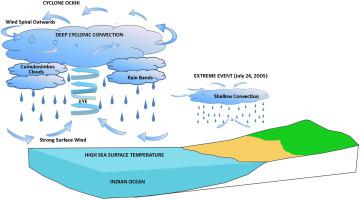当前位置:
X-MOL 学术
›
Glob. Planet. Change
›
论文详情
Our official English website, www.x-mol.net, welcomes your
feedback! (Note: you will need to create a separate account there.)
Stable isotopic (δ18O and δ2H) and geospatial approach for evaluating extreme rainfall events
Global and Planetary Change ( IF 4.0 ) Pub Date : 2020-11-01 , DOI: 10.1016/j.gloplacha.2020.103299 Md. Arzoo Ansari , Jacob Noble , Archana Deodhar , G.N. Mendhekar , Dilkash Jahan
Global and Planetary Change ( IF 4.0 ) Pub Date : 2020-11-01 , DOI: 10.1016/j.gloplacha.2020.103299 Md. Arzoo Ansari , Jacob Noble , Archana Deodhar , G.N. Mendhekar , Dilkash Jahan

|
Abstract Natural disasters are more frequent in the tropical region in the recent past due to anthropogenic forcing and consequent climate change. In this context, understanding the genesis and pattern of extreme rainfall events are important to devise disaster management plans. Two natural disaster events, Cyclone Ockhi (05 December 2017) and a torrential rainfall event (944 mm in 24 h) occurred on 26 July 2005, that has caused large scale devastation, loss of lives and properties, in Mumbai, India were evaluated using stable isotopes (δ18O and δ2H) of precipitation and geospatial data. Both the events were analysed and compared to understand their occurrences, moisture source regions and deduce the atmospheric factors responsible for their formation. Distinctly depleted stable isotopic content in rains were observed during the Cyclone Ockhi, while, during the extreme rainfall event, it was same as that of the normal monsoon rains, which is attributed to the dynamic nature of the moisture. The depleted isotopic signature of the cyclone may be because of the isotopic fractionation effect caused by the organized convective condition and vapour recycling along the trajectory. The genesis, structure and pattern of both the extreme events were evaluated using Sea Surface Temperature (SST), Outgoing Longwave Radiation (OLR) and Relative Humidity (RH) data. Wind pattern and moisture transport pathways were derived using HYSPLIT backward trajectory model. Prevalence of high SST over the southwest Bay of Bengal and adjoining areas of Sri Lanka as well as in the Arabian Sea was responsible for the genesis and intensification of the Cyclone Ockhi. The extremely low OLR value indicated intense and deep convection over the region during the cyclone. The large scale altitudinal variation in RH created unstable condition in the troposphere, consequently, strengthened the cyclone. The intensive shallow convection, continuous supply of moisture from the Arabian Sea and the orographic uplifting of clouds at the Western Ghats were responsible for the occurrence of torrential rainfall on 26 July 2005 in Mumbai. The wind pattern during the cyclone was distinct; it was circular and ascending upward, while, it was more or less horizontal and was descending downwards during the torrential rainfall event. The atmospheric processes responsible for the occurrence of two natural disaster rain events were also conceptualized. Although, the isotope data is limited, the study is first of its kind and it provides better insights into the genesis, intensification of the extreme rainfall events that are essential for forecasting, planning disaster mitigation measures and in warning strategies of this region.
中文翻译:

用于评估极端降雨事件的稳定同位素(δ18O 和 δ2H)和地理空间方法
摘要 近年来,由于人为强迫和随之而来的气候变化,热带地区的自然灾害更加频繁。在这种情况下,了解极端降雨事件的起源和模式对于制定灾害管理计划很重要。使用 Ockhi 飓风(2017 年 12 月 5 日)和 2005 年 7 月 26 日发生的暴雨(24 小时内 944 毫米)这两个自然灾害事件对印度孟买造成了大规模破坏、生命和财产损失的事件进行了评估。降水和地理空间数据的稳定同位素(δ18O 和 δ2H)。对这两个事件进行了分析和比较,以了解它们的发生、水分来源区域并推断导致它们形成的大气因素。在气旋 Ockhi 期间观察到降雨中稳定同位素含量明显耗尽,而在极端降雨事件期间,它与正常季风降雨相同,这是由于水分的动态性质。气旋的耗尽同位素特征可能是由于有组织的对流条件和沿轨迹的蒸汽再循环引起的同位素分馏效应。使用海面温度 (SST)、传出长波辐射 (OLR) 和相对湿度 (RH) 数据评估了这两个极端事件的发生、结构和模式。使用 HYSPLIT 后向轨迹模型推导出风模式和水分输送路径。孟加拉湾西南部和斯里兰卡附近地区以及阿拉伯海的高 SST 流行是气旋 Ockhi 的起源和加剧的原因。极低的 OLR 值表明气旋期间该地区有强烈而深的对流。RH的大尺度海拔变化造成对流层不稳定条件,从而加强了气旋。2005 年 7 月 26 日在孟买发生暴雨的原因是强烈的浅对流、来自阿拉伯海的持续供应水分以及西高止山脉的地形抬升。气旋期间的风型很明显;它是圆形的,向上上升,而在暴雨事件期间,它或多或少是水平的并向下下降。还概念化了导致两次自然灾害降雨事件发生的大气过程。虽然同位素数据有限,
更新日期:2020-11-01
中文翻译:

用于评估极端降雨事件的稳定同位素(δ18O 和 δ2H)和地理空间方法
摘要 近年来,由于人为强迫和随之而来的气候变化,热带地区的自然灾害更加频繁。在这种情况下,了解极端降雨事件的起源和模式对于制定灾害管理计划很重要。使用 Ockhi 飓风(2017 年 12 月 5 日)和 2005 年 7 月 26 日发生的暴雨(24 小时内 944 毫米)这两个自然灾害事件对印度孟买造成了大规模破坏、生命和财产损失的事件进行了评估。降水和地理空间数据的稳定同位素(δ18O 和 δ2H)。对这两个事件进行了分析和比较,以了解它们的发生、水分来源区域并推断导致它们形成的大气因素。在气旋 Ockhi 期间观察到降雨中稳定同位素含量明显耗尽,而在极端降雨事件期间,它与正常季风降雨相同,这是由于水分的动态性质。气旋的耗尽同位素特征可能是由于有组织的对流条件和沿轨迹的蒸汽再循环引起的同位素分馏效应。使用海面温度 (SST)、传出长波辐射 (OLR) 和相对湿度 (RH) 数据评估了这两个极端事件的发生、结构和模式。使用 HYSPLIT 后向轨迹模型推导出风模式和水分输送路径。孟加拉湾西南部和斯里兰卡附近地区以及阿拉伯海的高 SST 流行是气旋 Ockhi 的起源和加剧的原因。极低的 OLR 值表明气旋期间该地区有强烈而深的对流。RH的大尺度海拔变化造成对流层不稳定条件,从而加强了气旋。2005 年 7 月 26 日在孟买发生暴雨的原因是强烈的浅对流、来自阿拉伯海的持续供应水分以及西高止山脉的地形抬升。气旋期间的风型很明显;它是圆形的,向上上升,而在暴雨事件期间,它或多或少是水平的并向下下降。还概念化了导致两次自然灾害降雨事件发生的大气过程。虽然同位素数据有限,











































 京公网安备 11010802027423号
京公网安备 11010802027423号